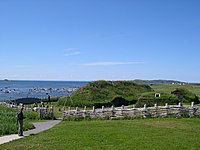Difference between revisions of "Rooftop farming"
| Line 1: | Line 1: | ||
| − | [[ | + | [[File:Groendakmetklaproos op Halve Wereld.jpg|thumb|400px|right|Green roofs on apartments blocks in Amsterdam]] |
: ''Topic in [[Gardening courses]]. By [[User:John|John Eagles]].'' | : ''Topic in [[Gardening courses]]. By [[User:John|John Eagles]].'' | ||
: ''This page is under construction'' | : ''This page is under construction'' | ||
Revision as of 14:45, 24 July 2012
- Topic in Gardening courses. By John Eagles.
- This page is under construction
Rooftop farming is the practice of cultivating food on the rooftop of buildings while a roof garden is any garden on the roof of a building. One particular type of a roof garden is the green roof or living roof, a roof of a building covered with vegetation and a growing medium, planted over a waterproofing membrane. An older form of the green roof is the sod roof, which traditionally was applied on houses in Scandinavia. Sod roofs are composed of several layers of birch bark covered with sods.
Green roof
Sod roof
History
Between ca 200 to ca 500 BCE there were built the ancient ziggurats or temple towers of ancient Mesopotamia. The oldest of these constructions were sun-dried brick towers had stepped terraces with a temple at its summit. Archeologists have discovered that large trees had been planted on the upper terraces of the towers.[1].
King Nebuchadnezzar II who ruled between 605 and 562 BC built the Hanging Gardens of Babylon.[2] The gardens were built for his wife, Amytis of Media, who longed for the plants of her homeland. According to estimates the gardens would have required at least 37,000 liters of water per day.
Roof gardens must have been an essential part of Roman life in Pompeii. One such roof garden was found in the Villa of Mysteries.[3]
The Palazzo Piccolomini[4] was the private summer residence of Pope Pius II. The city of Pienza where the palazzo is located was one of the first examples of Renaissance town planning. Atop Pius II's palazzo was a magnificent roof garden filled with sculpted trees.[5]
"A sod roof or turf roof is a traditional Scandinavian type of green roof covered with sod on top of several layers of birch bark on gently sloping wooden roof boards. Until the late 19th century, it was the most common roof on rural log houses in large parts of Scandinavia."[6] Sod roofs added an additional layer of insulation and protection to the house.
In the late 1800s rooftop gardens began appearing in New York City. The first major roof garden was built on top of the Casino Theatre at Broadway in 1882. Other theatres followed, for example Madison Square Garden and Winter Gardens.[5]
In modern architecture, throughout the 1920s Le Corbusier developed the 'Five Points of Architecture,' which became the new model for architectural design. The fifth point was the roof garden to compensate for the green area consumed by the building and replacing it on the roof.[7]
Gallery
See also
References
- ↑ The history of roof top design
- ↑ Hanging Gardens of Babylon Wikipedia
- ↑ Villa of the Mysteries Wikipedia
- ↑ Pienza, section Palazzo Piccolomini Wikipedia
- ↑ 5.0 5.1 A brief history of roof gardens
- ↑ Sod roofs Wikipedia
- ↑ Le Corbusier, section Five Points of Architecture Wikipedia
External links
- A brief history of roof gardens
- Green roof Wikipedia
- Green roof photos
- Greenroofs.com
- Kensington Roof Gardens Wikipedia
- National Geographic Green Roofs Photo gallery
- Roof garden Wikipedia
Videos
Comments
- You need to be logged into your Facebook account to post comments











